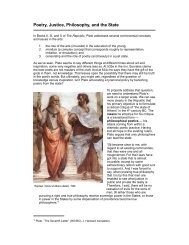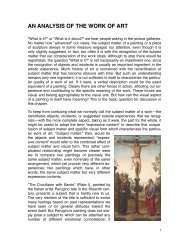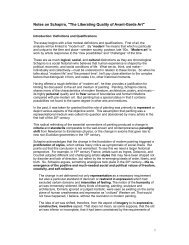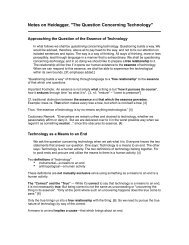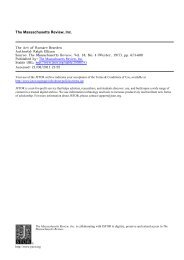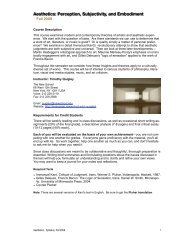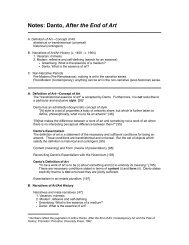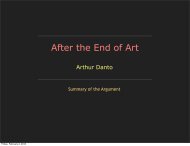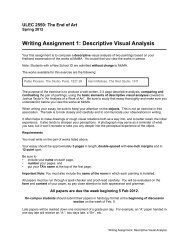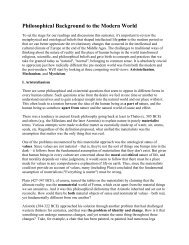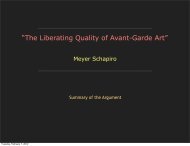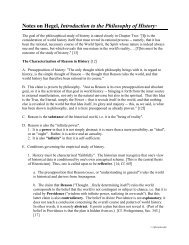You also want an ePaper? Increase the reach of your titles
YUMPU automatically turns print PDFs into web optimized ePapers that Google loves.
“A thing or person of the samekind or category as another.”This paragraph seems to developthe notion of intersubjectivity in anadmittedly indirect manner.M-P argues for the autonomy ofthe painter.general, must return to the "there is" which precedes it; to the site, the soil of the sensible<strong>and</strong> humanly modified world such as it is in our lives <strong>and</strong> for our bodies—not thatpossible body which we may legitimately think of as an information machine but thisactual body I call mine, this sentinel st<strong>and</strong>ing quietly at the comm<strong>and</strong> of my words <strong>and</strong>my acts. Further, associated bodies must be revived along with my body—"others," notmerely as my congeners, as the zoologist says, but others who haunt me <strong>and</strong> whom Ihaunt; "others" along with whom I haunt a single, present, <strong>and</strong> actual Being as no animalever haunted those of his own species, territory, or habitat. In this primordial historicity,science's agile <strong>and</strong> improvisatory thought will learn to ground itself upon thingsthemselves <strong>and</strong> upon itself, <strong>and</strong> will once more become philosophy….Now art, especially painting, draws upon this fabric of brute meaning whichoperationalism would prefer to ignore. Art <strong>and</strong> only art does so in full innocence. From thewriter <strong>and</strong> the philosopher, in contrast, we want opinions <strong>and</strong> advice. We will not allowthem to hold the world suspended. We want them to take a st<strong>and</strong>; they cannot waive theresponsibilities of humans who speak. Music, at the other extreme, is too far on the hitherside of the world <strong>and</strong> the designatable to depict anything but certain schemata of Being—its ebb <strong>and</strong> flow, its growth, its upheavals, its turbulence.Only the painter is entitled to look at everything without being obliged to appraise what hesees. For the painter, we might say, the watchwords of knowledge <strong>and</strong> action lose theirmeaning <strong>and</strong> force. Political regimes which denounce "degenerate" painting rarelydestroy paintings. They hide them, <strong>and</strong> one senses here an element of "one neverknows" amounting almost to an acknowledgment. The reproach of escapism is seldomaimed at the painter; we do not hold it against Cézanne that he lived hidden away atL'Estaque during the Franco-Prussian War. And we recall with respect his "life isfrightening," although the most insignificant student, after Nietzsche, would flatly rejectphilosophy if he or she were told that it did not teach us how to live life to the fullest. It isas if in the painter's calling there were some urgency above all other claims on him.Strong or frail in life, but incontestably sovereign in his rumination of the world,possessed of no other "technique" than the skill his eyes <strong>and</strong> h<strong>and</strong>s discover in seeing<strong>and</strong> painting, he gives himself entirely to drawing from the world—with its din of history'sglories <strong>and</strong> sc<strong>and</strong>als—canvases which will hardly add to the angers or the hopes ofhumanity; <strong>and</strong> no one complains. [2] What, then, is the secret science which he has orwhich he seeks? That dimension which lets Van Gogh say he must go "still further"?What is this fundamental of painting, perhaps of all culture?IIOn the “intertwining” or “chiasm”:“The...[term] indicates his newconception of the body, as a 'chiasm'or crossing-over (the term comesfrom the Greek letter chi) whichcombines subjective experience <strong>and</strong>objective existence. His term for thisnew conception of the body is'flesh' (chair) <strong>and</strong> he insists that it isan 'ultimate notion; a 'concreteemblem of a general manner ofbeing; which provides access both tosubjective experience <strong>and</strong> objectiveexistence.”[Thomas Baldwin, Maurice Merleau-Ponty: Basic Writings, New York:Routledge, 2004.]The painter "takes his body with him," says Valery. Indeed we cannot imagine how a mindcould paint. It is by lending his body to the world that the artist changes the world intopaintings. To underst<strong>and</strong> these transubstantiations we must go back to the working,actual body—not the body as a chunk of space or a bundle of functions but that bodywhich is an intertwining of vision <strong>and</strong> movement.I have only to see something to know how to reach it <strong>and</strong> deal with it, even if I do notknow how this happens in the nervous system. My moving body makes a difference inthe visible world, being a part of it; that is why I can steer it through the visible. Moreover,it is also true that vision is attached to movement. We see only what we look at. Whatwould vision be without eye movement? And how could the movement of the eyes notblur things if movement were blind? If it were only a reflex? If it did not have its antennae,its clairvoyance? If vision were not prefigured in it?All my changes of place figure on principle in a corner of my l<strong>and</strong>scape; they are carriedover onto the map of the visible. Everything I see is on principle within my reach, at leastwithin reach of my sight, <strong>and</strong> is marked upon the map of the "I can." Each of the twomaps is complete. The visible world <strong>and</strong> the world of my motor projects are both total2



